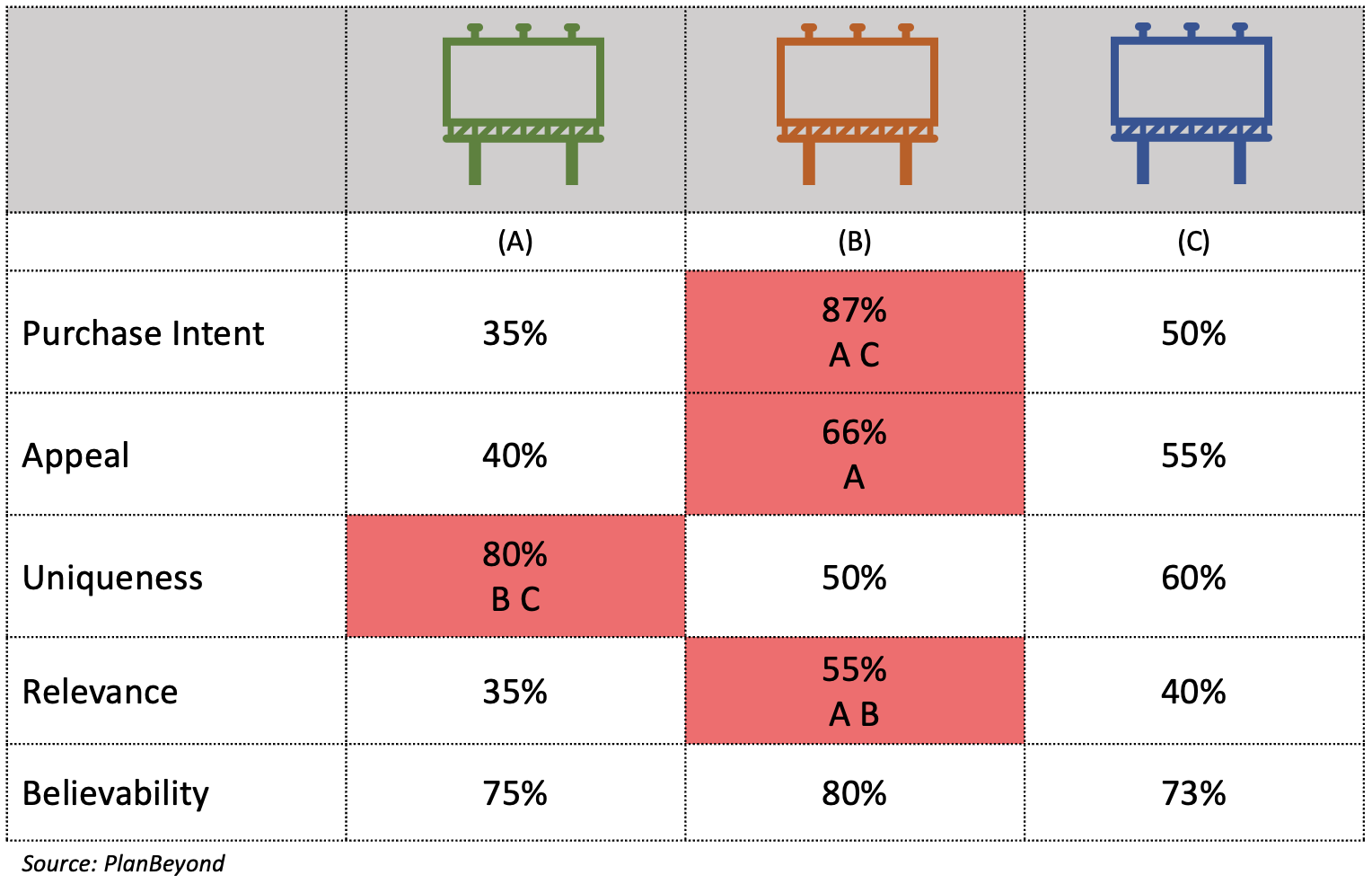Don’t you want your ads to perform well? And, don’t you want to avoid spending tens of thousands of dollars on media fees that don’t improve sales?
Ad creative testing lets you hit both of these “birds” with one stone.
It’s a streamlined market research approach to collect an initial read on the relative appeal of different ad messages and creatives before you go live. You’ll understand which one resonates strongly across the board, and you’ll see if it holds unique appeal to certain customer segments. It’s an ideal way to mitigate financial risk and hit the bullseye out of the gate.
What Types of Ads To Test
With digital ad creative testing, you can test any kind of ad. This could be a TV ad, print ad, a web display ad, or even a radio ad. As long as you have a digital file, we can upload it into a survey platform and get testing.
That said, you’ll want at least two separate creatives. This will let you see if one creative over- or under-performs for certain sentiments.
We just have one rule of thumb: Make sure each ad is equally “done.” This means do not show one creative in a fairly raw format and one that is beautifully stylized. The “pretty” one will always win. Keeping things consistent for a truly fair test.
What To Measure When Doing Ad Creative Testing
Ads need to create a wide host of feelings. If it’s for an insurance company, the ad should likely engender trust, confidence, and security. Meanwhile, snack food brands may need to create feelings of fun, excitement, and maybe even danger (we’re looking at you, Flamin’ Hot Cheetos).
Regardless of this brand or product-specific sentiments, there are few classic ad creative testing dimensions that make it into nearly every study:
- Purchase Intent: You want people to buy your product, right? Make sure you ask how likely they are to buy the product they see in the ad.
- Relevance: The ad message must be relevant for people to want what you’re selling. Be sure to ask how relevant the ad’s messages, claims, and value props are to your respondents.
- Believability: People might want something, but they need to actually believe the product can deliver. Asking about believability, especially if you’re making more extreme claims, helps vet this out.
- Uniqueness: Advertising is sometimes about standing out from the pack. This is why probing on uniqueness, or differences from other products on the market, is frequently part of ad creative testing.
How Ad Creative Research Tests Are Structured
The process for actually testing an ad creative with a particular audience is fairly straightforward.
- Finalize Ad Creative: Get internal buy-in on the 2, 3, 4, or more ads for testing. Keep in mind the more ads, the more respondents you’ll need in your study. This is often why most research keeps it to 3-5 ads.
- Determine Your Respondent Profile: Who do you want actually seeing your ads? This is who we want to recruit into the study. It could be existing customers, lapsed customers, prospective customers, or people in a market you’re about to enter.
- Show One Ad To A Respondent: For ad creative testing, we like taking a monadic research approach. This is a fancy word that just means each respondent only sees one ad. It limits the survey length, which is great for keeping respondents’ attention. Also, it makes sure their answers are not influenced by any prior creative they just saw.
- Ask The Same Sets Of Questions: Regardless of which creative they see, ask each respondent the exact same set of questions. Doing so lets you get an apples-to-apples read across creatives.
Keep in mind, most ad creative testing is done online via digital surveys. This is a great way get results quickly and reach a really wide range of potential respondents.
Ad Creative Testing Output
Once all of the data is in, it’s time to see how each ad performed!
Let’s look at the pretend output data on the right to see how this all plays out. Each column represents the way respondents reacted to each ad creative. Meanwhile, each row shows the metric of interest.
What becomes very clear after doing this ad creative testing is that Ad B outperforms the others creatives. In particular, it over-indexes for Purchase Intent and Appeal. Meanwhile, Ad A ranks strongly for Uniqueness. However, sometimes uniqueness isn’t a good thing. And, in this case, it appears that uniqueness is inversely related to appeal.
We’ll also point out that we are looking at the statistically significant differences between the creatives. This refers to those little letters in the table. What this means is that we want to know with a certain level of confidence that the data for one creative is truly higher or lower than another. Said another way, we want confidence that these differences are not the result of sampling errors.

You may also want to slice and dice the data by unique customer segments. For instance, let’s say you really want to appeal to women between the ages of 25-30 while not alienating males between 18-25. Distill the results down by each of these groups. This will show which ad creative tests extremely well with women and is, at worst, neutral to men.
What To Do When Your Testing Is Complete
Depending on how perfected the ad creative is, you’ll have a few next steps.
Some companies use ad creative testing with basic storyboards. This level of roughness means getting very early reads on ideas the audience will enjoy. If this is the type of creative tested, next steps often include selecting a storyboard and moving into ad development.
Other time, we’re testing fully complete ads. This means these ads are ready to go live in-market…so long as the test performs well. If this is the case, companies often do one of two things. They may select a series of well-scoring ads to run in a given region or even nationally. Or, they may push ads live in different markets or geographies for an even larger, real-world test.
All of these are great outcomes. It’s usually the company’s size and resources which determine which approach they ultimately pursue.





